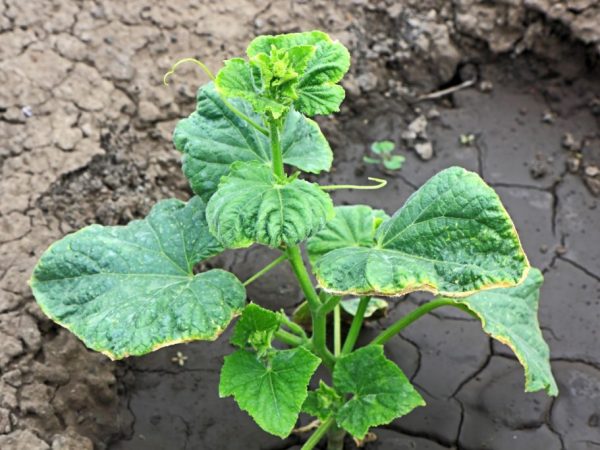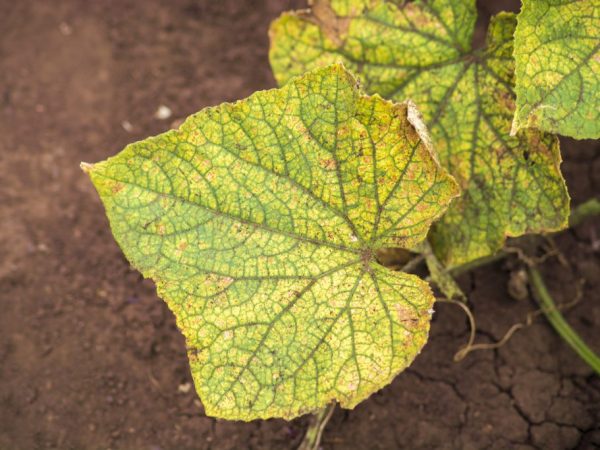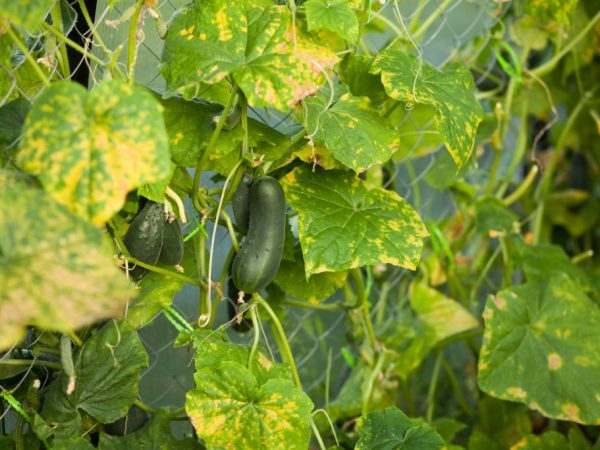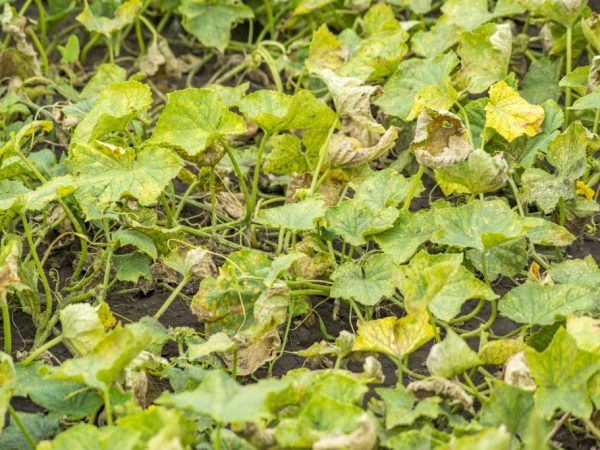Processing yellowed cucumber leaves
Cucumbers are considered simple and easy to grow and care for. But, like any other plant in the garden, this vegetable requires attention. And especially when there are any negative changes on the plants. Often, gardeners are faced with yellowing of the leaves. At such a moment, the question arises of how to process the leaves of cucumbers if they dry and turn yellow. But, do not rush to processing without finding out the reasons for such a problem.

Processing yellowed cucumber leaves
The main causes of yellowing
Yellowing of the leaves in cucumbers indicates a violation of the vegetation. And to solve the problem, you need to understand what exactly caused such a violation.
Yellowing occurs for the following reasons:
- lack of lighting;
- sunburn;
- violation of the water regime;
- sudden changes in temperature, hypothermia;
- nutritional deficiencies;
- damage by pests;
- infection with viral or fungal diseases.
Depending on the cause of the occurrence, yellowing will have its own characteristics. To determine them, it will be enough to carefully examine the bushes. The damage will be different:
- localization;
- shades;
- the contours of yellowed places;
- accompanying symptoms.
Based on the causes of yellowing, appropriate measures can be taken. In each case, they will be different.
Lack of lighting
Lack of lighting can occur at different stages of development. Most often, this problem can be observed during the period of growing seedlings or already during fruiting.
If the leaves turn yellow at the seedling stage, then most often this occurs due to the location or cloudy spring days. In the event of a lack of light, they will become pale with a yellowish tinge. This is due to the slowed down processes of photosynthesis and insufficient amounts of nutrients produced. This problem can be easily solved by simply rearranging the seedlings to a more illuminated place or illuminating with a phytolamp. And in a short time, the cucumbers will acquire their original bright green color.
Sometimes the leaves of adult plants dry out, this is an inevitable process.
Having built up a large mass of greenery, the bushes begin to shade each other. Those at the bottom of the stem do not receive enough light. This is a natural process. In such a situation, you can remove the yellowed and dried leaves and slightly thin out the bushes, cutting off the extra non-fruiting whips. Such measures can partially extend the growing season.
Sunburn
If small yellow spots with clear outlines appeared on the bushes, and the day before, watering was carried out in sunny and hot weather. The reason for this yellowing is a burn. Such yellowing will not harm the bushes, but it should be remembered that watering the plants should be done in the morning or afternoon.And it is strictly forbidden to water the bushes under the scorching sun.
Violation of the water regime

Drought affects plants
Cucumbers, like all pumpkin plants, are moisture-loving plants. Lack of moisture and drought are common causes of yellowing and drying. On the bushes, the tips of the leaves first dry, and then the entire leaf.
Solving this problem will not be difficult. It is enough to adjust the watering, to carry it out regularly in sufficient quantity. Favorably affects the condition of the bushes and spraying with water. But it is important to remember that overflow, like drying out, can be harmful.
Sudden changes in temperature, hypothermia
If the day before there was a drastic decrease in temperature, cold rains, nighttime cold snaps, then the plants very quickly respond to such stressful conditions. And the leaves of the cucumbers may start to turn yellow. This is due to the fact that when the temperature drops, the crops absorb nutrients poorly, and accordingly, the nutrition of the vegetative organs is disturbed. Stabilization of the temperature regime will lead to the normalization of the state of the cucumbers, and the leaves will stop turning yellow.
If, according to the forecast of the cold, you drag on, it is worth covering the cucumbers with a non-woven cloth. White agrofiber is well suited, it is light, transmits light, warms well. And they can even cover adult plants.
Nutrient Deficiency
In case of nutrient deficiency, treatment is simply necessary, and it must be done immediately.
Leaves can turn yellow both with a deficiency of the entire complex of nutrients, and with a lack of a certain trace element. Depending on what exactly the bushes are missing, it is necessary to decide how to process the stems and leaves of cucumbers.
Yellowing occurs with a deficiency:
- nitrogen;
- potassium;
- calcium;
- gland;
- magnesium.
You can determine what exactly is missing in cucumbers by considering the features of yellowing, as well as taking into account the accompanying symptoms.
Lack of nitrogen
Nitrogen plays an important role in the growth process. In case of a lack of it, not only the leaves will turn yellow, but other symptoms will also wilt:
- growth slows down;
- new shoots develop poorly;
- the ovary falls off.
In such a situation, the bushes need to be treated with nitrogen fertilizer, it can be both mineral and organic. Urea, chicken droppings will do.
Urea is used in a solution for foliar treatment. For this, 10 g of urea is dissolved in 10 l. The resulting solution is sprayed onto the plants. It will be enough to carry out two such dressings with an interval of 10 days.

The plant turns yellow with a lack of nitrogen
If organic growing of vegetables is preferable, then feeding with chicken manure is well suited to replenish nitrogen deficiency. For this, a solution is prepared. For 10 liters of water, it is enough to add a glass of droppings, mix well and leave to ferment for 2-3 days. The finished slurry is diluted with water. I add 250 ml of solution to a bucket of clean water. Such top dressing is added to the bushes, making sure that fertilizer does not fall on the plant.
Lack of potassium
With a deficiency of potassium, a yellow border is observed on the leaves along the entire edge, and over time they turn brown. In parallel with such yellowing, the following is observed:
- pulling lashes;
- lack of ovary.
Adequate amount of potassium plays an important role, since it is this trace element that helps assimilate other nutrients. A shortage of ego after a while will lead to a deficiency of other nutrients, because even if they are present in the soil, they will not be absorbed. To replenish the potassium supply for the processing of cucumbers, potassium, magnesium or ash, which is very rich in this trace element, is used.
Potassium magnesium is best used in the form of a solution, so it is absorbed faster by plants. To do this, 20 g of fertilizer granules should be dissolved in a bucket of water. With this solution, you can water the plants at the root or spray. Ash can be used both dry and in the form of an ash solution.When applied dry, add 2-3 tsp under one bush. ash is buried in the ground and watered with clean water. And you can also prepare a watering solution. A glass of ash is dissolved in a bucket of water and watered at the root, 0.5 liters of solution will be enough for one plant.
Lack of calcium
In case of calcium deficiency, the leaves first turn white, then curl and fall off. Often a lack of such a trace element occurs when growing plants on acidic soils. Therefore, the acidity should be checked and, if necessary, reduced. If the pH is normal, then you need to process the cucumbers with calcium sulfate, and also use eggshell dressing, which is dominated by easily digestible calcium.
Eggshells are washed, dried and ground into powder. Powder is added to the bushes. 1 tsp is enough for one plant. such feeding.
Lack of iron
With iron deficiency, so-called chlorosis occurs. With chlorosis, the leaves turn yellow, but the veins remain green. You can replenish the deficiency of this trace element with the help of ready-made preparations:
- Iron chelate;
- Micro Fe;
- Antichlorosis;
- Ferylene.
The drug is dissolved according to the instructions and sprayed with cucumbers.

The problem can be fought
You can also treat cucumbers with homemade iron chelate. This will require 10 g of ferrous sulfate and 20 g of ascorbic acid, they are dissolved in 1 liter of water. The solution is sprayed and poured onto the plants.
Lack of magnesium
With a deficiency of magnesium, the leaves change color from yellow to purple, the veins, as in chlorosis, are green for some time. In such a situation, cucumbers are treated with a solution of magnesium sulfate. For 10 liters of water, 20 g of fertilizer is enough. Processing is carried out after the beginning of flowering. Cucumbers are thoroughly sprayed. Such treatments need to be done 2-3 with a frequency of 10 days.
Pest infestation
Pests, settling on plants, parasitize and deplete them, as a result, the leaves begin to turn yellow and dry. Cucumbers can also be attacked by pests.
The main pests that infect:
- spider mite;
- aphid;
- whitefly;
- mealy worm.
With timely detection and processing, they will not be able to cause serious harm to cucumbers. For processing, you can use different, most effective means. Acaricides (Apollo, Aktelik, Oberon) will cope with spider mites and mealy worms. Aphids and whiteflies will help fight a wide range of insecticides (Confidor, Envidor, Sunmight)
Infections with fungal or viral diseases
The environment of fungal diseases, one of the symptoms of which is yellowing of the leaves and with which cucumbers can be affected, can be distinguished:
- fusarium;
- downy mildew;
- anthracnose.
When infected with Fusarium, in addition to yellowing, wilting of plants is also observed, and then thinning of the stems. If a disease is detected, it is necessary to treat with Trichodermin or Fundazole. In case of infection, these preparations are poured over the soil around the plant and sprayed.
If the cucumbers are affected by downy mildew, then on the outside of the leaf plate there will be yellow spots without clear outlines, and a whitish bloom below. Fungicides (Topsin, Acrobat, Metaxyl, etc.) will help to cope with steam sporosis. You can also use the folk method. It is necessary to prepare a solution with 25 g of soda, 5 g of soap and 5 liters of hot water, mix thoroughly. Cucumbers are sprayed with a cooled solution, and soil is shed near the bushes.
Another fungal disease in which the leaves turn yellow and dry is anthracnose. With anthracnose, yellowish spots appear, and then turn brown, and become up to 5 cm in diameter, localized along the edges and between the veins. In places of spots, tears appear after a while. With anthracnose, it is necessary to treat with fungicides (Quadris, Previkur, Poliram).
In case of infection of cucumbers with viral or bacterial diseases, yellowing and drying of the leaves may also occur.But with such diseases, the plants wither and die very quickly. And the only thing that can be done is to destroy the affected plants to prevent contamination of other crops.
Conclusion
There are many reasons for yellowing, and most are not difficult to deal with. But it will be much easier to prevent the occurrence of factors that can provoke it. Observing the correct agricultural techniques, make preventive treatments against pests and diseases with safe drugs. As a result, healthy and green cucumbers will grow.


